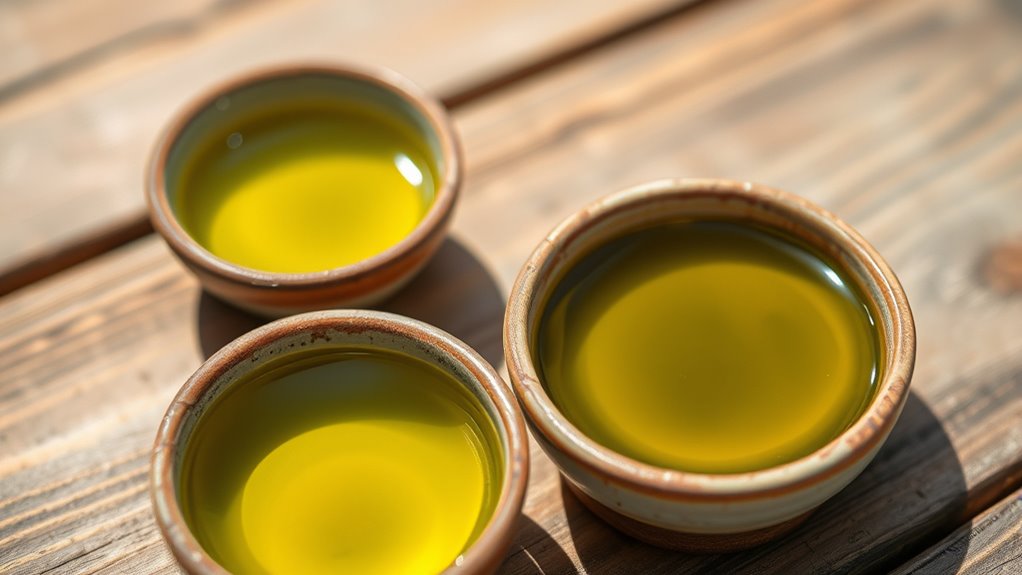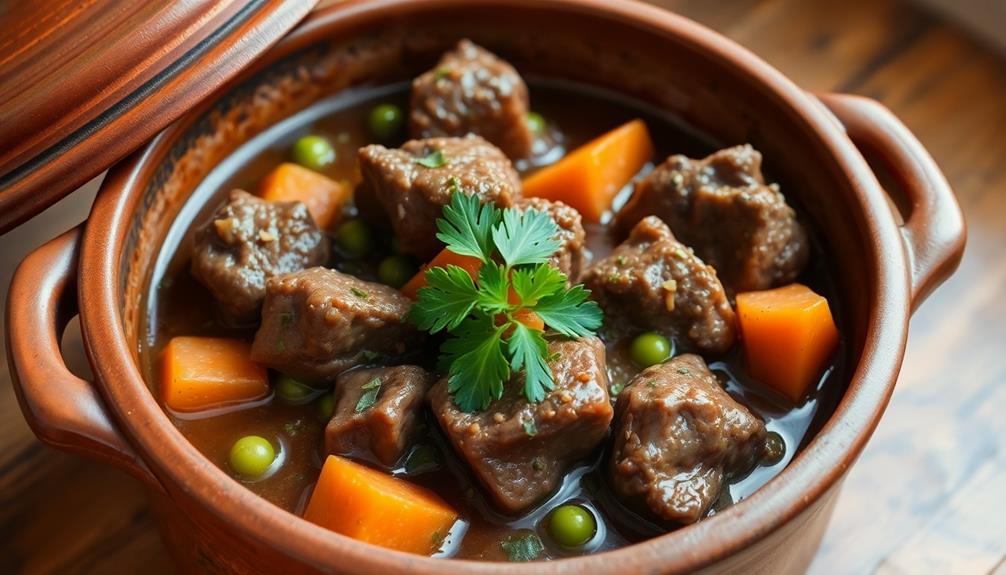Mediterranean olive oil grades vary mainly by acidity and flavor. Extra virgin ranks highest with less than 0.8% acidity, offering vibrant, fruity, and grassy notes. Virgin olive oil has up to 2% acidity and a milder flavor, while refined oils are processed to neutralize flavor with higher acidity. Your choice depends on taste and culinary use; if you want to learn more about how these factors influence quality, keep exploring the details.
Key Takeaways
- Extra virgin olive oil has an acidity below 0.8% and features vibrant, fruity, and balanced flavor profiles.
- Virgin olive oil has acidity up to 2% with slightly milder, more subdued flavors.
- Refined olive oils have higher acidity and lack distinctive flavor, processed with heat and chemicals.
- Flavor profiles vary by olive variety, with Picual being robust, Arbequina mild, and Koroneiki rich and fruity.
- Proper extraction and storage preserve flavor integrity and ensure the oil’s grade and quality.

Understanding the different grades of Mediterranean olive oil is essential if you want to choose a quality product. The grading system primarily hinges on acidity levels and flavor profiles, which reflect the oil’s purity and taste. When evaluating olive oil, you’ll notice that grades like extra virgin, virgin, and refined each have distinct characteristics. To grasp what sets them apart, it helps to understand the importance of olive oil extraction methods and the influence of Mediterranean olive varieties. Extra virgin olive oil is considered the highest quality grade. It’s obtained through cold-pressing or mechanical extraction methods that avoid heat and chemicals, preserving the oil’s natural flavor and nutrients. These olive oil extraction methods are pivotal because they prevent oxidation and maintain low acidity levels, typically below 0.8%. The flavor profile of extra virgin olive oil is often vibrant, grassy, and fruity, with a balanced bitterness and pungency. Your choice of Mediterranean olive varieties plays a significant role here; varieties like Picual, Arbequina, or Koroneiki each lend unique taste characteristics. Picual tends to be robust and peppery, while Arbequina offers a milder, buttery flavor, and Koroneiki provides a rich, fruity taste. Recognizing these differences helps you select an oil that suits your palate and culinary needs. Additionally, storage conditions are crucial to prevent degradation and preserve the flavor integrity of the oils over time. Proper storage in a cool, dark place helps maintain the quality of the oil, preventing oxidation and spoilage. Virgin olive oil is also produced using mechanical methods but may have slightly higher acidity, up to 2%. Its flavor can be a bit less intense or complex than extra virgin but still retains many of the natural fruity and fresh notes. As with extra virgin, the specific Mediterranean olive varieties influence the flavor, but the quality is slightly lower due to minor imperfections during extraction or storage. It’s suitable for cooking when a more affordable yet still flavorful oil is desired. Refined olive oils undergo processing that removes defects and impurities, often involving heat and chemical treatments. These oils typically have higher acidity and lack the vibrant flavor profiles found in virgin and extra virgin grades. They’re mainly used for frying or industrial purposes rather than for finishing dishes or drizzling over salads. The flavor profile is bland and neutral, emphasizing function over taste. Proper storage of olive oil is essential to maintain its flavor profiles and prevent oxidation, especially for high-quality grades like extra virgin.
Frequently Asked Questions
How Does Olive Oil Storage Affect Its Grade and Flavor?
You should pay attention to how you store olive oil, as storage conditions directly impact its grade and flavor. Keep it in a cool, dark place to prevent oxidation, which can spoil the oil. Proper storage extends its shelf life, maintaining its flavor and quality. Avoid exposure to light, heat, and air, all of which can degrade the oil quickly, affecting both its taste and grade over time.
Can Olive Oil Grades Vary Between Different Mediterranean Countries?
Did you know that olive oil grades can differ across Mediterranean countries due to regional labeling and varietal differences? You’ll notice some countries emphasize extra virgin standards more strictly, affecting grade consistency. These regional distinctions influence flavor profiles and acidity levels, meaning your olive oil might have a different grade depending on its origin. So, when choosing, consider regional labeling and varietal differences for the best quality and flavor.
What Are the Health Implications of Consuming Lower-Grade Olive Oil?
Consuming lower-grade olive oil may reduce the dietary benefits you get, as it often contains fewer olive oil antioxidants, which are key for health. These antioxidants help fight free radicals and may lower your risk of chronic diseases. While lower-grade oils still provide some benefits, choosing higher-quality olive oil guarantees you maximize the antioxidants and enjoy ideal health benefits. So, opt for better grades whenever possible.
How Does Harvest Time Influence Olive Oil Acidity and Flavor?
Harvest timing during olive ripening considerably impacts both acidity and flavor. If you harvest early, when olives are less ripe, you’ll get oil with lower acidity and more robust, bitter flavors. Later harvests, when olives are more mature, tend to produce oil with higher acidity and milder, fruitier profiles. By paying attention to olive ripening stages, you can influence the oil’s overall quality, flavor, and health benefits.
Are There Certifications to Verify Olive Oil Grades and Quality?
You’re wondering if there are certifications to verify olive oil grades and quality. Certification standards, like the IOC (International Olive Council) and USDA Organic, provide quality assurance by ensuring oils meet strict guidelines. These certifications help you trust the product’s purity, processing, and authenticity. Look for labels from reputable organizations, which confirm that the olive oil has been tested and meets specific standards for grade, acidity, and flavor.
Conclusion
Now that you understand the different Mediterranean olive oil grades, you hold a key to a treasure chest of flavors. Think of each bottle as a unique melody—some bold and lively, others gentle and soothing. Your palate is the compass that guides you through this rich landscape of acidity and flavor. So, explore each grade with curiosity and passion, and let your taste buds dance in the symphony of Mediterranean excellence.








